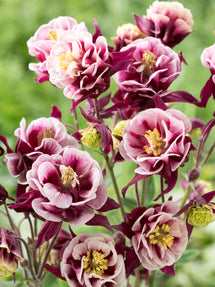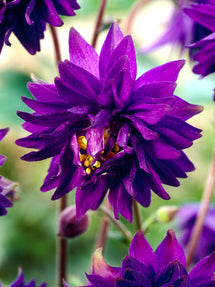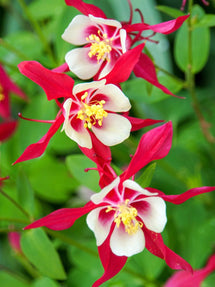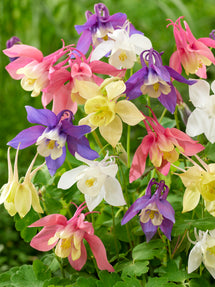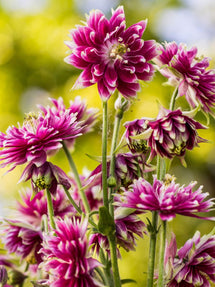Aquilegia (Columbine)
Transform Your Outdoor Space With The Delicate Allure Of Columbine
With their distinctive, whimsical flowers, Columbines bring a unique charm to late spring and early summer gardens throughout the UK. Whether you're creating a romantic cottage-style border or prefer a more formal garden setting, Columbines offer striking visual interest and effortless elegance. Easy to grow and low-maintenance, they are ideal for beginner gardeners, while seasoned enthusiasts equally appreciate their delicate beauty.
Explore DutchGrown’s collection of premium Columbine (Aquilegia) bare roots and elevate your garden into a breathtaking display this growing season.
Showing 1 - 6 in 6 items
Columbine: A Breathtakingly Beautiful Flower For Garden Landscapes
The Columbine flower, also known as ‘Aquilegia’, ‘Granny’s Bonnet’, or ‘Granny’s Nightcap’, is a captivating perennial prized for the distinctive elegance it brings to garden landscapes. Its botanical name, Aquilegia, derives from the Latin word ‘Aquila’, meaning eagle and refers to the bloom’s talon-like spurs.
The unusual, bell-shaped flowers, often two-toned, appear in a dazzling array of colours including purple, blue, pink, red, and white. Their vivid hues contrast beautifully with the plant’s deep green foliage and strikingly long spurs. Rich in nectar, Columbines are highly attractive to bees, butterflies, and other pollinators and insects, while their natural resistance to deer makes them a practical addition to wildlife-friendly gardens. In addition, Columbines produce superb, long-lasting cut flowers that are ideal for adding a touch of elegance to your summer bouquets.
Columbine Varieties: From Aquilegia ‘Canadensis’ To Aquilegia ‘Vulgaris’
With over 70 species, including Aquilegia ‘Canadensis’, Aquilegia ‘Vulgaris’ (Common Columbine), Aquilegia ‘Flabellata’, and Aquilegia ‘Longissima’, this charming flower shrub offers a delightful range of blooms and colours. Each one is unique as the gardener who grows it. With hues spanning from vibrant cherry red to rich, velvety purples, Columbines are a captivating addition to any garden setting.
Take, for example, the ever-popular Columbine ‘Nora Barlow’, renowned for its showy, double blooms in deep pink with pale green tips. It’s a wonderfully decorative choice for borders and beds. Another variety is the ‘Rocky Mountain’ Columbine, which has two-toned flowers with star-shaped, white petals and violet sepals. Are you looking for something more delicate yet colourful? The bonnet-shaped, almost black flowers of the herbaceous perennial Columbine ‘Black Barlow’ are an excellent addition to your outdoor space.
Growing Columbine For Maximum Bloom Time In Your Garden
Although Aquilegia is an easy-going, beginner-friendly perennial, proper planting and care are essential to ensure strong growth and extended flowering. You can choose to plant the bare roots in pots or into the ground.
Start by selecting a sunny or partially shaded position in your garden during early spring. The soil should be rich, moist, and well-drained, as overly wet conditions can lead to root rot. If your soil lacks nutrients, a general-purpose fertiliser can be applied to encourage healthy development. Next, prepare planting holes approximately 5 centimetres deep and space them 8 to 10 centimetres apart. Position the bare roots in the holes and gently cover with soil, ensuring the base of the stems remains just above ground level.
Once the roots are in place, water thoroughly to help settle the soil around the plants. Columbine generally requires minimal watering, as it is relatively drought-tolerant once established. However, it’s beneficial to water again after cutting the plant back post-flowering, as this encourages a flush of fresh foliage.
To keep your plants looking their best, regularly deadhead spent flowers after blooming. This not only helps maintain a tidy appearance but also prolongs the overall display. Columbine can be propagated by division or by sowing seeds.
With the right care, you’ll enjoy a beautiful display of Columbine flowers in late spring and early summer. Need further guidance? Explore our growing guide ‘How to Grow Columbine’ for more detailed information.
Discover DutchGrown’s Columbine Flower Bare Roots For Sale
At DutchGrown, our Columbine bare roots reflect decades of expertise in sourcing and selecting the highest quality plants. Whether you opt for rich purple blooms or striking bi-coloured varieties, you can look forward to an elegant floral display that brings beauty to your garden from late spring through to midsummer. Explore our exceptional collection of Aquilegia bare roots and elevate your outdoor space with premium plants, carefully chosen for performance and charm. We deliver throughout the UK.
Frequently Asked Questions About Columbine
Do Columbines Prefer Sun Or Shade?
Columbines flourish in full sun or partial shade. In warmer areas, it’s advisable to provide afternoon shade, for example, under a tree, to protect the plants from heat stress and prevent wilting. While they are adaptable to various conditions, they are unlikely to thrive in gardens with full, deep shade, which often results in poor flowering.
Where Is The Best Place To Plant Columbine Flowers?
The ideal spot for planting Columbine flowers is in an area that receives full sun to partial shade, with rich, moist but well-drained soil. These hardy perennials thrive in a wide range of climates. Aquilegia is a versatile choice for various garden styles, and works especially well in cottage gardens and rock gardens.
Does Columbine Bloom All Summer Long?
Columbine typically blooms from late spring to mid-summer, depending on the variety. As the temperatures rise, the blooms begin to fade, and the plant gradually dies back. To keep your garden looking neat, it’s advisable to deadhead the faded flowers to encourage a modest second flush of foliage. Although Aquilegia does not flower all summer, it returns each spring with a fresh and vibrant display.
Do Columbine Flowers Spread?
Columbine flowers can spread, although not through their compact root system. Instead, they primarily self-seed. Once established, Aquilegia will often reseed itself naturally, leading to new plants emerging in different areas of your garden, sometimes in delightful, unexpected places.
